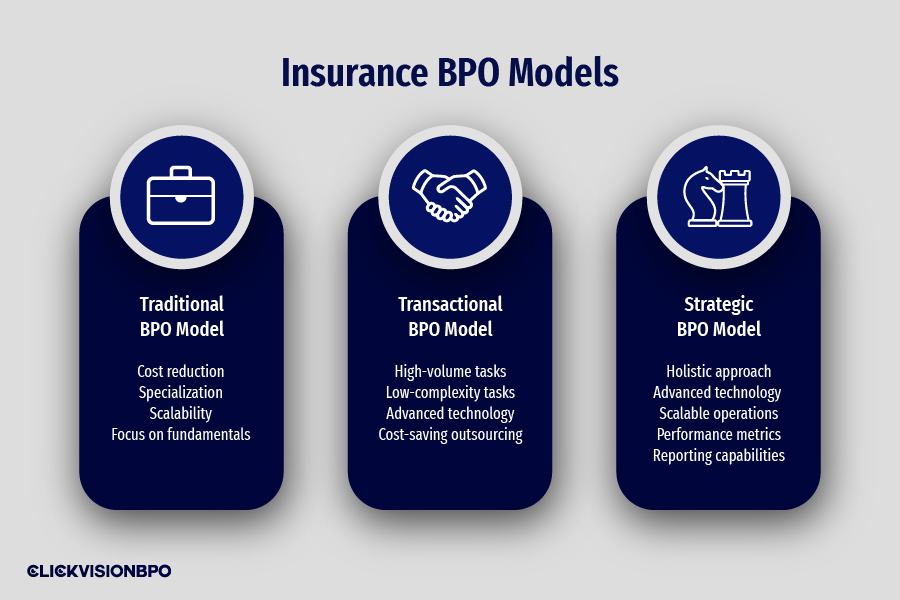BPO (business process outsourcing) in insurance is important because it benefits the companies. BPO allows companies to save on labor costs and let people from abroad take care of the non-core functions while domestic employees and managers can address core operations. Hence, the reason for the emergence of many insurance BPO models. The BPO models we are to elaborate on in-depth helped companies to stay competitive in the ever-growing market. What are the different insurance BPO models?
In this article, we will discover the different BPO models and discuss their key features, how they can benefit your company, and their cons.
Overview of Different Insurance BPO Models
In traditional BPO, an insurance agency outsources specific business functions to third-party service providers. Companies can address more important topics after handing back office services like data entry, claims processing, etc., to an insurance BPO.
There are three types of insurance BPO models: traditional, transactional, and strategic BPO. In the traditional BPO model, companies outsource specific business processes to third-party service providers. These processes are usually less essential for the company. The transactional model is similar but requires advanced technology for tasks like claim processing or financial accounting. Finally, strategic BPO focuses on the whole organization, including the core competencies.
Let’s reveal more details about each BPO model.
List of Insurance BPO Models
BPO companies are booming within the insurance market. No wonder different BPO models focus on specific tasks.
Traditional BPO Model
The traditional model is designed so the insurance company can outsource specific tasks, mostly non-essential, to the insurance outsourcing company. Companies like ours use this traditional BPO model when they have too much customer demand because of workforce shortage. This model is ideal for those providers who want to reduce their operational costs without losing work quality.
BPO is more affordable than an in-house team. For instance, if you have seen a growth opportunity in the healthcare industry, you could outsource claim management or sales rather than employing in-house staff.
Pros
- Lower wages– since the majority of insurance BPOs are located in developing countries where the cost of living and the minimum wage are low, companies can save on wages.
- Cost-saving– insurance BPOs have their own state-of-the-art infrastructure, consisting of technology, upscale offices, etc. By following this model, the insurance provider can save on these requirements.
- Skilled workforce– insurance BPOs have very experienced employees who specialize in performing tasks like policy administration, servicing, accounting, and claims processing.
Cons
- Lack of control– companies may have limited control over the outsourced operations, leading to potential issues with quality, performance, and customer satisfaction.
- Cultural barriers– language, time zones, and differences in business practices may cause communication and collaboration challenges.

Source: freepik.com / Photo Contributor: pressfoto
Key features
All in all, traditional BPO’s key features are cost reduction, specialization, scalability, and focus on fundamental competencies.
The traditional BPO model allows companies to have lower labor costs in offshore locations for non-essential tasks. On the other hand, BPO providers are experienced in specific areas, so companies can benefit from their knowledge and skills. Outsourcing makes companies able to scale their operations up or down as needed. Finally, companies can allocate their resources to fundamental business activities.
Transactional BPO Model
We believe that choosing a transactional BPO model is best when used for solving specific business problems and improving workflow when there is a hold-up in the work process. Moreover, this model is used when a business is growing rapidly but still has to expand its management framework. So, a transactional BPO model lets companies carry on with their everyday operations while they think of a long-term solution and focus on core functions.
Insurance providers decide to use the transactional BPO model when they do not have much time to dedicate to issues like setbacks in the work process. The insurance company can terminate the outsourced services after the insurance business process provider solves the problem. For example, if your accountant takes a long leave during a busy season, you can outsource such services in the meantime.
Pros
Besides the pros we mentioned with the traditional BPO model, this particular BPO model offers an even wider array of advantages:
- Fast processing of claims and checking policies– transactional BPO is great for processing sudden increases in claims and checking a great volume of policies.
- Scalability– the transactional BPO model is very scalable, allowing companies to easily increase or decrease their outsourcing operations based on business needs.
Cons
- Security and privacy risk– outsourcing transactional processes often includes sharing sensitive and confidential data with external service providers. This may lead to security and privacy risks, especially if there are no proper protective measures.
- Communication challenges– depending on the geographical location of the BPO provider, there may be potential language and cultural barriers that may negatively impact communication. Differences in time zones can also cause delays in resolving issues or getting real-time answers and updates.
Key features
The key features of the transactional BPO model are high-volume and low-complexity tasks. This model usually handles high-volume, not too complex, routine tasks. This data includes data entry, invoice processing, claims processing, checking claims, payroll processing, order completion, etc. The service provider applies advanced technology to improve process efficiency and speed.
Moreover, this model is cost-saving. It is designed to save costs by outsourcing simple and repetitive tasks to lower-cost locations. This model allows companies to benefit from knowledge and expertise at a lower cost.
Strategic BPO Model
Strategic outsourcing is designed to have a holistic approach to managing operations. So, this model encompasses the company’s strategy, processes, technology, and employees when outsourcing.
While the other two models aimed to solve specific problems within the organization, the strategic BPO model focuses on the organization as a whole.
For instance, in strategic outsourcing, BPO analyzes the skill set of the team members and gives them roles they are best at. So, this model aims to improve employee performance and operational efficiency.
Pros
- Cost-effectiveness– the strategic BPO model can help insurance agencies reduce their operational costs by outsourcing services at a lower cost.
- Access to talents, technology, and tools– by partnering with a strategic BPO provider, insurance agencies can have access to specialized talent and knowledge. This helps enhance service quality and stay competitive in the market.
Cons
- Transition challenges– moving from an in-house to a strategic BPO model can be complex and time-consuming. Insurance agencies need to invest in planning, training, and change management.
Key features
The key feature of strategic BPO is that this model takes a holistic approach and handles the organization as a whole. So, this model’s important features include robust technology infrastructure, scalable operations, performance metrics, and reporting.
A strategic BPO partner should have advanced technology, secure data storage, and analytics capabilities. As with any other model, strategic BPO is scalable and able to scale operations up or down based on the insurance company’s needs. Finally, the strategic BPO model includes performance metrics and regular reporting, allowing insurance companies to monitor the performance of the BPO provider.

Which Model Is the Most Effective?
The effectiveness of the BPO model can vary based on a company’s specific needs and goals. That is why we can not choose one model as the most effective.
For companies who want to improve daily operations, the traditional and transactional BPO models are the most effective. With these models, you can outsource repetitive and non-core processes while focusing on strategic initiatives in-house.
On the other hand, companies whose goal is to gain a competitive advantage and drive innovation may find the strategic BPO most effective. This model requires deeper collaboration between the client and service provider, leading to long-term values.
We are all about seeing your company grow. We, as an outsourcing company, are here to take off your burden. So, by choosing the perfect BPO model, you free up space to let your business focus on its strengths and let the employees concentrate on what’s important for the growth of the company.
Conclusion
If an insurance agency wants to stay competitive in today’s market, it may consider insurance BPO. So, what are the different insurance BPO models? The most important insurance BPO models are traditional, transactional, and strategic.
While the traditional and transactional models focus on less important specific tasks, the strategic BPO focuses on the whole organization. The three models have similar pros like cost-effectiveness and access to knowledge and skills of experts from overseas; they may show some disadvantages such as cultural barriers or security and privacy risks.
Nevertheless, a company like yours may benefit from a BPO model if it chooses the right one.

With a strong background in the marketing industry and healthcare leadership roles, Filip is responsible for CLICKVISIONBPO’s sales strategies and onboarding new clients. With a passion for sharing insights gained from his experience, he also shares valuable knowledge through industry related articles.
